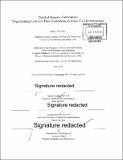| dc.contributor.advisor | Neri Oxman. | en_US |
| dc.contributor.author | Van Zak, Joshua. | en_US |
| dc.contributor.other | Program in Media Arts and Sciences (Massachusetts Institute of Technology) | en_US |
| dc.date.accessioned | 2020-01-23T17:02:18Z | |
| dc.date.available | 2020-01-23T17:02:18Z | |
| dc.date.copyright | 2018 | en_US |
| dc.date.issued | 2019 | en_US |
| dc.identifier.uri | https://hdl.handle.net/1721.1/123643 | |
| dc.description | Thesis: S.M., Massachusetts Institute of Technology, School of Architecture and Planning, Program in Media Arts and Sciences, June, 2019 | en_US |
| dc.description | Cataloged from PDF version of thesis. | en_US |
| dc.description | Includes bibliographical references (pages 82-88). | en_US |
| dc.description.abstract | This thesis introduces and evaluates directed biogenic fabrication: a philosophical approach and technical framework for co-fabricating ecologically active civil infrastructure with living cells. I propose that imbuing our buildings and urban systems with life, or at least biologic capabilities, will enable tight interconnections between fundamental species occupying different infrastructural niches, resulting in urban ecosystems that develop and evolve closed-loop resource cycles and equilibrate our atmosphere. As a proof of concept for this generalizable approach, I cover three strategies demonstrating specific tools, techniques, and assessment methods for designing elements of a living infrastructure: (1) Programmable Surface Features and Hydrophilicity -utilizing organic chemistry, computational design, and digital fabrication to engender particular mechanical properties and responsiveness in biopolymer materials; Communication Ecology-templating visual and conformational signals in biopolymer materials that communicate information about the environment to other organisms; and Opportunistic Chimeric Design-exploiting and co-opting the most powerful capabilities evolution has produced in order to grow infrastructural lifeforms. The first two methods are exemplified through two architectural scale pavilions -Aguahoja I and II-while the third is shown through a series of prototypical materials synthesized by two types of bone cancer cells. This thesis makes contributions to the fields of materials science, biological engineering, civil engineering, digital fabrication, and computational design.. | en_US |
| dc.description.statementofresponsibility | by Joshua Van Zak. | en_US |
| dc.format.extent | 88 pages | en_US |
| dc.language.iso | eng | en_US |
| dc.publisher | Massachusetts Institute of Technology | en_US |
| dc.rights | MIT theses are protected by copyright. They may be viewed, downloaded, or printed from this source but further reproduction or distribution in any format is prohibited without written permission. | en_US |
| dc.rights.uri | http://dspace.mit.edu/handle/1721.1/7582 | en_US |
| dc.subject | Program in Media Arts and Sciences | en_US |
| dc.title | Directed biogenic fabrication : programming cells and their ecosystems to grow civil infrastructure | en_US |
| dc.title.alternative | Programming cells and their ecosystems to grow civil infrastructure | en_US |
| dc.type | Thesis | en_US |
| dc.description.degree | S.M. | en_US |
| dc.contributor.department | Program in Media Arts and Sciences (Massachusetts Institute of Technology) | en_US |
| dc.identifier.oclc | 1136611405 | en_US |
| dc.description.collection | S.M. Massachusetts Institute of Technology, School of Architecture and Planning, Program in Media Arts and Sciences | en_US |
| dspace.imported | 2020-01-23T17:02:18Z | en_US |
| mit.thesis.degree | Master | en_US |
| mit.thesis.department | Media | en_US |
